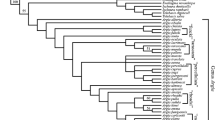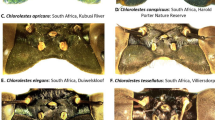Abstract
A phylogenetic and systematic study of Orius species (Heteroptera: Anthocoridae) from Korea has been conducted using both morphological and molecular characters. Thirty morphological character states were coded for 10 strains of 9 species. Five molecular markers, partial cytochrome c oxidase I (COI), cytochrome b (CytB), 16S rRNA (16S), 18S rRNA (18S), and 28S rRNA (28S), from mitochondrial and nuclear genes, were tested. Phylogenetic analyses based on molecular data were conducted by minimum evolution, maximum parsimony, maximum likelihood, and Bayesian phylogenetic (BP) analyses. Analysis of morphological data was performed using the parsimony programs NONA, and the combined dataset of morphological and molecular data was analyzed using BP analyses. The results of this study indicate that use of COI and CytB enabled relatively effective identification of species, whereas the sequences of 16S, 18S and 28S did not enable identification of closely related species such as Orius minutus and O. strigicollis. We discuss the usefulness of the five molecular markers for determining phylogenetic relationships and identifying the species.





Similar content being viewed by others
References
Brower AVZ (2006) Problems with DNA barcodes for species delimitation: ‘ten species’ of Astrapters fulgerator reassessed (Lepidoptera: Hesperiidae). Syst biodivers 4:127–132
Campbell BC, Ross GF, Woodward TE (1995) Paraphyly of Homoptera and Auchenorrhyncha inferred from 18S rRNA nucleotide sequence. Syst Entomol 20:175–194
Carayon J (1958) Etudes sur les Hemipteres Cimicoidea. Mem Mus Natn D’Hist nat A 16:141–172
Carayon J (1961) Chapter XII Hemiptera (Heteroptera): Anthocoridae. In: South African animal life, results of the Lund University expedition in 1950–1951, vol 8, Almqvist and Wiksells Boktryckeri AB, Uppsala, pp 533–557 (26 figs)
Carayon J (1972) Caractéres systematiques et classification des Anthocoridae (Hemipt.). Ann Soc Entomol France (N.S.) 7:737–770
Castresana J (2002) GBLOCKS: selection of conserved blocks from multiple alignments for their use in phylogenetic analysis. Version 0.91b. Copyrighted by J. Castresana, European Molecular Biology Laboratory (EMBL)
Crozier RH, Crozier YC (1993) The mitochondrial genome of the honeybee Apis mellifera: complete sequence and genome organization. Genetics 113:91–117
Crozier RH, Dobric N, Imai HT, Craur D, Cornuet JM, Taylor RW (1995) Mitochondrial-DNA sequence evidence on the phylogeny of Australian jack-jumper ants of the Myrmecia pilosula complex. Mol Phylogen Evol 4:20–30
Deligeorgidis PN (2003) Predatory effect of Orius niger (Wolff) (Hem., Anthocoridae) on Frankliniella occidentalis (Pergande) and Thrips tabaci Lindeman (Thysan., Thripidae). J App Entomol 126:82–85
Farris JS, Källersjö M, Kluge AG, Bult C (1994) Testing significance of incongruence. Cladistics 10:315–319
Fathi SAA, Nouri-Ganbalani G (2009) Prey preference of Orius niger (Wolf.) and O. minutus (L.) from Thrips tabaci (Lind.) and Tetranychus urticae (Koch.). J Entomol 6:42–48
Felsenstein J (1985) Confidence limits on phylogenies: an approach using the bootstrap. Evolution 39:783–791
Folmer O, Black M, Hoeh W, Lutz R, Vrijenhoek R (1994) DNA primers for amplification of mitochondrial cytochrome c oxidase subunit I from diverse metazoan invertebrates. Mol Mar Biol Biotechnol 3:294–299
Goloboff PA (1998) NONA, version 2.0. Program and documentation. American Museum of Natural History, New York
Harry M, Solignac M, Lachaise D (1998) Molecular evidence for parallel evolution of adaptive syndromes in fig breeding Lissocephala (Drosophilidae). Mol Phylogen Evol 9:542–551
Hebert PDN, Cywinska A, Ball SL, DeWaard JR (2003a) Biological identifications through DNA barcodes. Proc R Soc Lond B Biol Sci 270:313–321
Hebert PDN, Ratnasingham S, deWaard JR (2003b) Barcoding animal life: cytochrome c oxidase subunit 1 divergences among closely related species. Proc R Soc Lond B Biol Sci 270:96–99
Herbert PDN, Penton EH, Burns JM, Janzen DG, Hallwachs W (2004) Ten species in one: DNA barcoding reveals cryptic species in the neotropical skipper butterfly Astraptes fulgerator. Proc Natl Acad Sci USA 101:14812–14817
Hillis DM, Dixon MT (1991) Ribosomal DNA: molecular evolution and phylogenetic inference. Q Rev Biol 66:411–453
Honda JY, Nakashima Y, Yanase T, Kawarabata T, Hirose Y (1998) Use of the internal transcribed spacer (ITS-1) region to infer Orius (Hemiptera: Anthocoridae) species phylogeny. Appl Entomol Zool 33:567–571
Honda JY, Nakashima Y, Yanase T, Kawarabata T, Takagi M, Hirose Y (1999) Isoelectric focusing electrophoresis and RFLP analysis: two methods for immature Orius spp. identification. Appl Entomol Zool 34:69–74
Jung S, Kim H, Yamada K, Lee S (2010) Molecular phylogeny and evolutionary habitat transition of the flower bugs (Heteroptera: Anthocoridae). Mol Phylogenet Evol 57:1173–1183. doi:10.1016/j.ympev.2010.09.013
Jung S, Duwal R, Lee S (2011a) COI barcoding of true bugs (Insecta: Heteroptera). Mol Ecol Res. doi:10.1111/j.1755-0998.2010.02945.x (in press)
Jung S, Yasunaga T, Lee S (2011b) Taxonomic review of the genus Orius (Heteroptera: Anthocoridae) in the Korean Peninsula. J Asia Pac Entomol 14:64–74. doi:10.1016/j.aspen.2010.11.014
Kambhampati S, Smith PT (1995) PCR primers for amplification of four insect mitochondrial gene fragments. Insect Mol Biol 4:233–236
Kerzhner IM (1988) Key to the insects of the Far East of the USSR, vol II: Homoptera and Heteroptera. Leningrad Nauka Publishing House, Leningrad
Kim I, Park J, Kim S, Kim S, Paik C (2004) Biological control of Thrips palmi (Thysanoptera: Thripidae) with Orius strigicollis (Hemiptera: Anthocoridae) on cucumber in plastic houses in the Southern Region of Korea. J Asia Pac Entomol 7:311–315
Kimura M (1980) A simple method for estimating evolutionary rate of base substitutions through comparative studies of nucleotide sequences. J Mol Evol 16:111–120
Kumar S, Tamura K, Nei M (2004) MEGA3: integrated software for molecular evolutionary genetics analysis and sequence alignment. Brief Bioinform 5:150–163
Lattin JD (1999) Bionomics of the Anthocoridae. Annu Rev Entomol 44:207–231
Muraji M, Kaisaki K, Shimizu T (2000a) Nucleotide sequence variation and phylogenetic utility of the mitochondrial COI fragment in anthocorid bugs (Hemiptera: Anthocoridae). Appl Entomol Zool 35:301–307
Muraji M, Kaisaki K, Shimizu T (2000b) Phylogenetic utility of nucleotide sequences of mitochondrial 16S ribosomal RNA and cytochrome b genes in anthocorid bugs (Hemiptera: Anthocoridae). Appl Entomol Zool 35:293–300
Nei M (1991) Relative efficiencies of different tree-making methods for molecular data. In: Miyamoto MM, Cracraft J (eds) Phylogenetic analysis of DNA sequences. Oxford University Press, New York
Nei M (1996) Phylogenetic analysis in molecular evolutionary genetics. Annu Rev Genet 30:371–403
Péricart J (1972) Faune de l’Europe et du Bassin Méditierréen. No. 7. Hémiptéres Anthocoridae, Cimicidae et Microphysidae de l’Ouest-Palearctique. Mason et Cie, Paris
Posada D, Crandall KA (1998) Modeltest: testing the model of DNA substitution. Bioinformatics 14:817–818
Reuter OM (1884) Monographia Anthocoriarum Orbis terrestris Helsingfors. Finska Litteratur-Sallskapets tryckeri, Helsingfors
Ronquist F, Huelsenbeck JP (2003) MrBayes 3: Bayesian phylogenetic inference under mixed models. Bioinformatics 19:1572–1574
Schuh RT, Weirauch C, Wheeler WC (2009) Phylogenetic relationships within the Cimicomorpha (Hemiptera: Heteroptera): a total-evidence analysis. Syst Entomol 34:15–48
Simon C, Frati F, Beckenbach A, Crespi B, Liu H, Flook P (1994) Evolution, weighting, and phylogenetic utility of mitochondrial gene sequences and a compilation of conserved polymerase chain reaction primers. Ann Entomol Soc Am 87:651–701
Swofford DL (1998) PAUP*. Phylogenetic analysis using parsimony (* and other methods), version 4.0b10. Sinauer Associates, Sunderland
Swofford DL, Olsen G, Waddell PJ, Hillis DM (1996) Phylogenetic inference in molecular systematics. Sinauer Associates, Sunderland, pp 407–514
Tautz D, Hancock JM, Webb DA, Tautz C, Cover GA (1988) Complete sequences of the rRNA genes of Drosophila melanogaster. Mol Biol Evol 5:366–376
Thompson JD, Gibson TJ, Plewniak F, Jeanmougin F, Higgins DG (1997) The ClustalX windows interface: flexible strategies for multiple sequence alignment aided by quality analysis tools. Nucleic Acids Res 24:4876–4882
Tian Y, Zhu W, Li M, Xie Q, Bu W (2008) Influence of data conflict and molecular phylogeny of major clades in Cimicomorphan true bugs (Insecta: Hemiptera: Heteroptera). Mol Phylogenet Evol 47:581–597
von Dohlen CD, Moran NA (2000) Molecular data support a rapid radiation of aphids in the Cretaceous and multiple origins of host alternation. Biol J Linn Soc 71:689–717
Yasunaga T (1997a) The flower bug genus Orius Wolff (Heteroptera: Anthocoridae) from Japan and Taiwan, Part I. Appl Entomol Zool 32:355–364
Yasunaga T (1997b) The flower bug genus Orius Wolff (Heteroptera: Anthocoridae) from Japan and Taiwan, Part II. Appl Entomol Zool 32:379–386
Yasunaga T (1997c) The flower bug genus Orius Wolff (Heteroptera: Anthocoridae) from Japan and Taiwan, Part III. Appl Entomol Zool 32:387–394
Acknowledgments
The authors thank Dr Hyojoong Kim, Dr Kazutaka Yamada, Dr Tomohide Yasuanga, Dr Tadashi Ishikawa, Dr Randall T. Schuh, Dr Kim A. Hoelmer, Mr Sangwook Park, Mr Gary Pixsely, and Ms Ram K. Duwal for their assistance with sampling and for valuable discussion. This research was supported by a grant from the Agenda Project (grant no. 102966290) and Biogreen 21 Program (grant no. 034032), by the Rural Development Administration in the Republic of Korea.
Author information
Authors and Affiliations
Corresponding author
Electronic supplementary material
Below is the link to the electronic supplementary material.
Rights and permissions
About this article
Cite this article
Jung, S., Lee, S. Phylogenetic and systematic study of Korean Orius species (Heteroptera: Anthocoridae) on the basis of molecular and morphological data. Appl Entomol Zool 46, 153–164 (2011). https://doi.org/10.1007/s13355-011-0024-3
Received:
Accepted:
Published:
Issue Date:
DOI: https://doi.org/10.1007/s13355-011-0024-3




